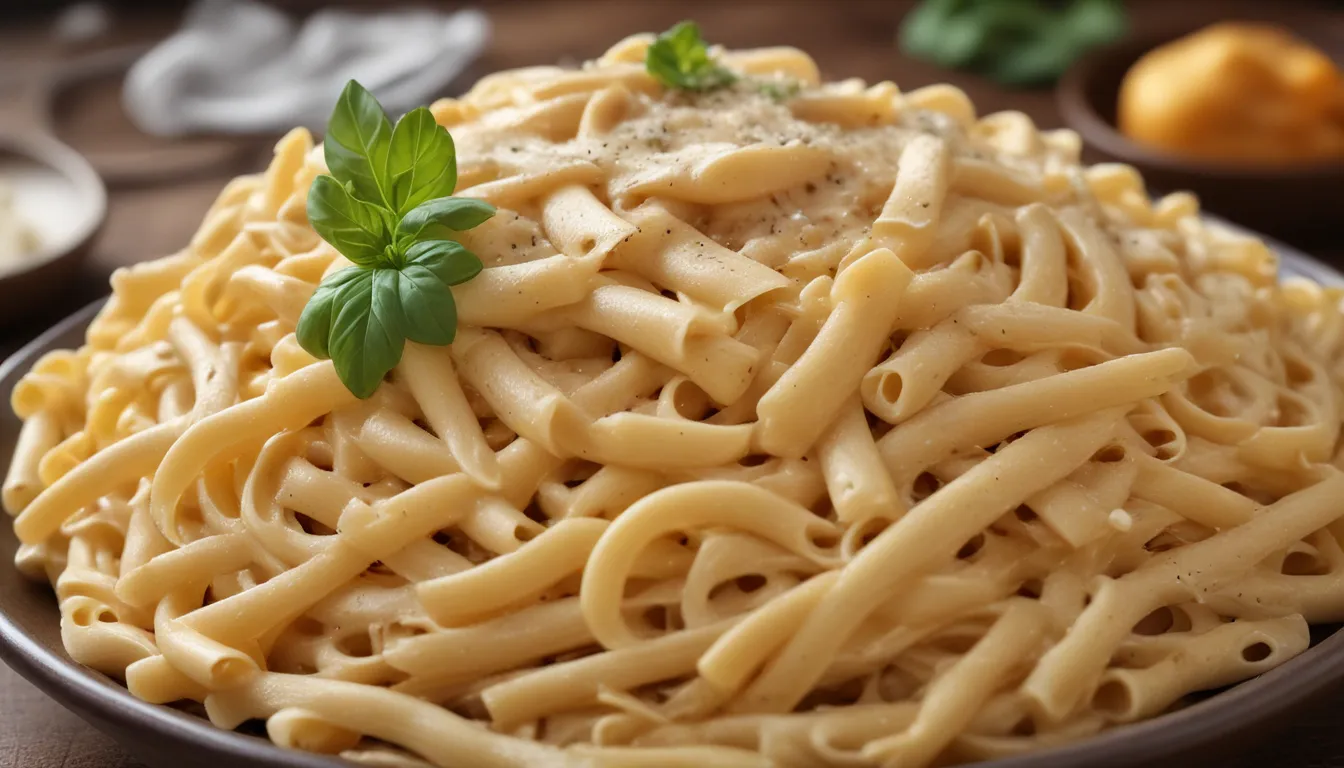The pictures in our articles might not always show exactly what the text is talking about. We use these images to make the article more interesting and eye-catching. They are there to add to the text, but not to replace it or show every detail.
Alfredo pasta, with its creamy and indulgent sauce, is a beloved dish that has captured the hearts and taste buds of many food enthusiasts. Whether enjoyed as a comforting weeknight meal or served up as a decadent treat on special occasions, Alfredo pasta is a classic favorite. But as with any dish, it’s important to know the nutritional information to make informed choices about what we’re putting into our bodies. In this article, we will explore the nutrition facts of Alfredo pasta, diving into its calorie content, fat and cholesterol levels, and other key nutritional components. So, if you’re curious about the nutritional profile of this delicious pasta dish, keep reading to discover the facts behind the flavor!
Key Takeaways:
- Indulging in creamy Alfredo pasta occasionally can be a delightful treat, but be mindful of its high calorie, fat, and sodium content. Balance it with vegetables and lean protein for a more nutritious meal.
- Portion control is key when enjoying Alfredo pasta. Be aware of standard portion sizes to manage your calorie and nutrient intake. Make healthier choices in your overall diet for a balanced lifestyle.
The Nutritional Breakdown of Alfredo Pasta
When it comes to Alfredo pasta, understanding its nutritional content can help you make informed decisions about your diet. Let's dive into the key components of this creamy dish:
Calories
One serving of Alfredo pasta can contain around 600-800 calories, depending on the portion size and additional ingredients. It's essential to be mindful of your overall calorie intake, especially if you're watching your weight.
Fat Content
Alfredo pasta is high in fat, with one serving containing approximately 40-50 grams of fat. Most of the fat comes from the butter and heavy cream used in the sauce. While fat is an essential nutrient, consuming it in excess can lead to health issues such as weight gain and heart disease.
Saturated Fat
The creamy sauce in Alfredo pasta is rich in saturated fat, with one serving providing around 20-25 grams. Consuming high amounts of saturated fat may increase the risk of heart disease, so it's important to enjoy this dish in moderation.
Cholesterol
Due to the generous use of cheese and butter, Alfredo pasta is high in cholesterol, with one serving containing about 100-150 milligrams. High cholesterol levels can contribute to heart disease, so it's advisable to monitor your intake and make healthier choices.
Protein
Despite its rich and creamy nature, Alfredo pasta is not a significant source of protein. One serving typically contains around 10-15 grams of protein. To boost the protein content of your meal, consider adding lean protein sources like chicken or shrimp.
Carbohydrates
Alfredo pasta is relatively high in carbohydrates, with one serving providing approximately 50-60 grams. These carbs mainly come from the pasta itself, so be mindful of your carb intake if you're watching your blood sugar levels.
Fiber
Unfortunately, Alfredo pasta is not a good source of dietary fiber, as it generally lacks substantial amounts of vegetables or whole-grain ingredients. To increase your fiber intake, consider adding fiber-rich side dishes like a crisp salad or steamed vegetables.
Sodium
Be cautious when consuming Alfredo pasta, as it can be high in sodium. One serving may contain around 800-1000 milligrams, which is about half of the recommended daily intake. High sodium intake can lead to high blood pressure and other health issues, so it's essential to monitor your salt intake.
Calcium
The Parmesan cheese used in Alfredo pasta provides a decent amount of calcium, with one serving supplying around 300-400 milligrams. Calcium is essential for bone health, so enjoy this cheesy dish as a source of this vital nutrient.
Vitamins
Alfredo pasta is not a significant source of vitamins, as it lacks vegetables or other nutrient-rich ingredients. It is often served with additional toppings or side dishes to enhance its nutritional value. To ensure you're meeting your vitamin requirements, incorporate a variety of fruits and vegetables into your diet.
Tips for a Healthier Alfredo Pasta Experience
While indulging in Alfredo pasta occasionally can be a delightful treat, it's crucial to remember its high calorie, fat, and sodium content. Here are some tips to make your Alfredo pasta experience healthier and more satisfying:
- Balance your meal with vegetables: Incorporate vegetables like broccoli, spinach, or mushrooms into your Alfredo pasta to add fiber, vitamins, and minerals to your dish.
- Choose lean protein: Add grilled chicken, shrimp, or tofu to your Alfredo pasta to boost its protein content and make it a more well-rounded meal option.
- Opt for whole wheat or gluten-free pasta: Choose whole wheat or gluten-free pasta options to increase the fiber content of your meal and make it a healthier choice.
- Make your own sauce: Store-bought Alfredo sauces often contain additives and preservatives. Making your own sauce with fresh ingredients can be a healthier alternative and allows you to control the ingredients and seasonings.
Conclusion
In conclusion, Alfredo pasta can be a delicious and satisfying meal option. While it may not be the healthiest choice due to its high calorie and fat content, it can still be enjoyed in moderation as part of a balanced diet. Adding vegetables or lean proteins to the dish can boost its nutritional value and make it more wholesome. Remember to consider portion sizes and opt for whole wheat or gluten-free pasta options if desired. Overall, indulging in Alfredo pasta occasionally can be a treat for your taste buds, but it's essential to be mindful of its nutritional profile and make smart choices to maintain a well-rounded diet.
FAQs
- How many calories are in a serving of Alfredo pasta?
A typical serving of Alfredo pasta contains around 600-800 calories, depending on the portion size and the ingredients used.
- Is Alfredo pasta high in fat?
Yes, Alfredo pasta is high in fat due to the butter, cream, and cheese that are typically used in the sauce. It is recommended to consume it in moderation and balance it with other healthier food choices.
- Can I make Alfredo pasta healthier?
Absolutely! You can make Alfredo pasta healthier by using alternatives like low-fat milk or Greek yogurt instead of heavy cream, using whole wheat or gluten-free pasta, and adding vegetables or lean proteins to the dish.
- Is Alfredo pasta suitable for vegetarians?
Yes, Alfredo pasta can be made vegetarian-friendly by omitting any meat or seafood. You can enhance its flavor with vegetables like broccoli, mushrooms, or spinach.
- Is Alfredo pasta gluten-free?
Traditional Alfredo pasta is not gluten-free as it uses regular wheat-based pasta. However, gluten-free pasta options are available that can be used to make a gluten-free version of this dish.
Enjoy your Alfredo pasta in moderation and explore healthier variations to satisfy your cravings while nourishing your body. Bon appétit!






